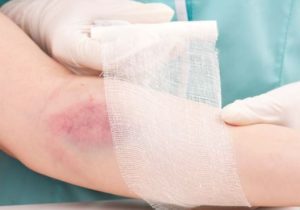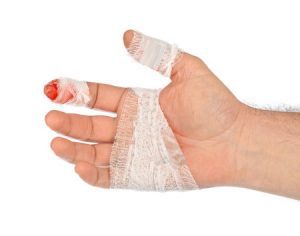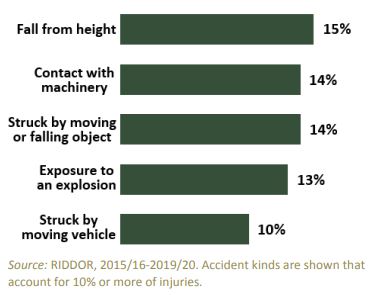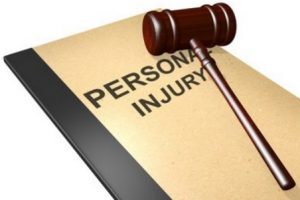By Stephen Hudson. Last Updated 11th June 2024. A chemical burn injury at work can be a frightening experience. The sudden burning of acid or a caustic spillage can be panic-inducing and distressing. If you came into contact with dangerous substances whilst doing your job and were injured due to employer negligence, it’s possible that you may be entitled to a chemical burn at work compensation amount.
Acid burns can cause scarring and, in severe cases, damage skin tissue to the point that it affects joints, muscles and even organs. The health implications of this can be very far-reaching.
Stringent laws in the UK exist to protect your rights in the workplace with chemicals and could enable you to claim damages if an employer failed to protect you properly.
To find out more about how a chemical burn at work compensation claim could help you today, get in touch with our advisors at Legal Expert. Simply call or write to us by:
- Ringing 0800 073 8804
- Emailing or writing to Legal Expert
- Using the ‘live support’ option, bottom right

Select A Section
-
- What Is A Chemical Burn At Work Claim?
- Types Of Chemical Burn Injuries
- Common Causes Of Chemical Burn Injuries
- Chemical Spillage Injuries
- Unsafe Transportation And Storage Of Hazardous Chemicals
- Chemical Burn At Work Compensation Calculator
- Compensation For Medical And Other Expenses
- No Win No Fee Chemical Burn At Work Compensation Claims
- Read More
What Is A Chemical Burn At Work Claim?
Employers owe their staff a duty of care as established under the Health and Safety at Work etc. Act 1974. This legislation means that employers should take reasonable steps to protect their workers from harm while they are in the workplace and performing their work-related duties. This also includes workplaces that handle dangerous chemicals and substances.
You may be eligible to start a chemical burn at work compensation claim against your employer if such an incident occurs and the following applies:
- Your employer owed you a duty of care.
- This breached this duty of care. For example, they failed to provide you with any personal protective equipment (PPE), such as safety goggles and gloves.
- This breach caused you to suffer a chemical burn injury.
How Long Do I Have To Make A Chemical Burn Injury Compensation Claim?
There is usually a three-year time limit for starting a personal injury claim, such as chemical burn at work claims, as established by the Limitation Act 1980.
This time limit can work differently for those who were injured under the age of 18 or who lack the mental capacity to handle their own legal proceedings.
To learn more about these exceptions or for more advice regarding your eligibility to claim compensation for a chemical burn at work, please contact our team of advisors for free today.
Types Of Chemical Burn Injuries
What are the symptoms of a chemical burn? Given the wide breadth of different chemicals used in modern workplaces, a symbol chart can be a simple way to group relevant chemicals in order of toxicity. Furthermore, this system can offer an instant visual aid to:
- Identify the chemical
- Describe how toxic it is
- What treatment needs to be instantly administered in cases of contact
Danger labels seek to instantly explain if the substance process produces a gas, any fumes, dust, vapour or mist when being used or stored. Is it dangerous to inhale or could it harm your skin? How likely is harm in the correct and normal use of this substance? What immediate actions need to be taken if there is contact with skin? Clear and easy to access advice and information is key to the correct prevention of chemical injury.
Despite adequate warnings, when a chemical comes into contact it can:
- Burn the skin; from first (superficial) to third-degree burns (burning tissue and nerve endings). Exposed areas such as fingers, hands and forearms can be most at risk as can eyes, mouths or noses.
- Cause caustic burns on the inside of the lungs if inhaled
- Create organ damage
- Lead to long term health conditions (such as leukaemia)
Common Causes Of Chemical Burn Injuries
Accidents can happen in the best-run factories and workplaces, but a rigid adherence to health and safety procedures can greatly reduce risks. In view of this, employers need to conduct regular risk assessments and work practice reviews to limit dangers before they happen.
Meeting with safety representatives and listening to the concerns of staff could also be an essential way to pre-empt possible accidents. Unfortunately, despite clear recommendations and rules, some common causes of accidents can still be:
- Unsafe storage arrangements
- Poorly labelled chemicals
- Inappropriate handling or transportation
- Failure to check the information that came with the product, such as the safety data sheet
- Inadequate training or lack of supervision
- Failure to be provided with personal protective equipment (PPE) where necessary
As the innocent victim of a chemical burn at work, you may know all too well how needless the accident was. If you have actual evidence to support a claim that your employer failed to owe you a duty of care and you were injured as a result, your chemical burns at work compensation claim could start sooner than you realise. Speak with our advisors for help.
Chemical Spillage Injuries
Certain commonly-used substances are more likely to cause burns in a workplace environment when they spill or fall or leak from containers during use, transportation or storage. Any of the following regularly accessible chemicals could cause chemical burns and may be found in any number of typical workplace environments:
- Ammonia
- Battery acid
- Bleach
- Concrete mix
- Drain or toilet bowl cleaners
- Metal cleaners
- Pool chlorinators
Although less commonly encountered, other hazardous substances can carry even greater risk. A huge array of chemicals can be used in modern manufacturing processes. Each presents its own particular set of hazards. Suffice to say that each one should always carry its own particular warning and be stored or handled according to strict regulation.
Any container or receptacle that is not maintained or fit for purpose runs the risk of allowing that chemical to leak onto surfaces or be breathed in. Furthermore, changing containers or mixing chemicals is strongly advised against unless proper precautions are taken.
Corroded tins or leaking canisters can be a prime concern. Spillages should be attended to promptly, where reasonable, and the correct methods for cleaning up that particular substance should be deployed as per guidance.
Unsafe Transportation And Storage Of Hazardous Chemicals
The transportation, storage and disposal of dangerous spillages is also something that is regulated carefully. The Control of Substances Hazardous to Health Regulations 2002 provides legal guidance for the proper storage and moving of dangerous or toxic substances so that spillages and accidents can be avoided.
It’s essential that chemicals are never swapped or put into different containers without appropriate precautions taken. This runs the risk of them (depending on the chemical) eroding unsuitable receptacles and also being inaccurately identified during an emergency.
Employers (and employees) have a responsibility to understand the properties of hazardous chemical waste and how to handle or dispose of them correctly. Anyone who produces, transports or receives hazardous chemical waste should treat it in accordance with The Hazardous Waste (England and Wales) Regulations 2005.
Under certain circumstances, any business involved in recycling or waste procedures may have obligations under Registration, Evaluation, Authorisation and Restriction of Chemicals (UK REACH) to ensure chemicals are handled with the observance of safety. Organisations should identify and control the risks of substances that are manufactured and marketed in Great Britain.
Chemical Burn At Work Compensation Calculator
Under the Health and Safety at Work etc. Act 1974, employers are potentially liable for costs associated with your injuries if their negligence caused them. Therefore, calculating compensation is possible by, firstly, sitting for a medical assessment with an independent medical professional.
The expert can look at the full extent of your injuries and then provide your personal injury lawyer with something called a medico-legal report. This report can act as evidence to prove:
- The accident caused or worsened your injuries.
- The severity of your injuries.
Impartial and unbiased, it aims to provide an accurate account of injury and prognosis in your case. Your solicitor can also use the report to help value your injuries.
In addition, a solicitor can cross-reference the report with injuries listed in a publication called the Judicial College Guidelines (JCG). The JCG provides award bracket amounts that aim to offer a consistent figure for various injuries. These figures can be based on the following:
- Pain and suffering caused
- Impact on mental health
- Damage to personal relationships
- Amenity in life
- Mental health damage
Serious burns could detrimentally affect you in all the areas mentioned above. Because of this, the JCG reserves some of its highest award brackets to acknowledge just how devastating burn injuries can be. The compensation table below illustrates this.
| Injury | Severity | Compensation Amount |
|---|---|---|
| Multiple Serious Injuries With Special Damages | Serious | Up to £250,000+ |
| Burns | Serious burn injuries | Likely to exceed £127,930 |
| Facial Scarring | Very Severe | £36,340 to £118,790 |
| Facial Scarring | Less Severe | £21,920 to £59,090 |
| Facial Scarring | Significant Scarring | £11,120 to £36,720 |
| Injuries Affecting Sight | (e) Complete loss of sight in one eye | £60,130 to £66,920 |
| Injuries Affecting Sight | (h) Minor Eye Injuries | £4,820 to £10,660 |
| Dermatitis | (a) Both hands | £16,770 to £23,430 |
| Dermatitis | (b) One hand or both | £10,550 to £13,930 |
It’s important to note that these amounts are not certified or guaranteed. They are merely a guide amount.
What’s more, if you can’t see your injuries in the compensation table above, reach out to our advisors. They give free estimates of what you could claim.
Compensation For Medical And Other Expenses
After a serious chemical burn in the workplace, you could be subject to many additional demands on your finances as you try to cope and adapt. Compensation for financial losses caused by an injury is known as special damages.
A few examples might be:
- Experiencing a loss of earnings due to from being unable to work
- Loss of future income if your injuries mean you can no longer work in that role
- Damage to your pension or attendance allowance
- Extra help is needed as you recover at home
- Adaptations to your home or car if you’ve suffered a disability that necessitates them
- Travel costs to hospital or therapy appointments
- Cosmetic surgery costs
- Counselling and therapy costs that aren’t covered by the NHS
- Pain medications and creams
- Forfeited deposits for events you could not attend
A No Win No Fee lawyer can work closely with you and help track and record this lost money both now and in the future. By compiling the actual cost of your injuries with receipts, bills, bank statements and invoices, it’s possible to present an accurate picture of the full impact of the accident. You can then include this in your claim against your employer and potentially recover the costs.
No Win No Fee Chemical Burn At Work Compensation Claims
As you learn to adjust to life after your chemical burn accident, you may be considering claiming. It is not unreasonable to expect that employers should safeguard your safety at work and if a simple and avoidable failure caused all these problems, you could take steps.
When considering your options, you may decide that claiming against your employer is the right course of action, but how? A No Win No Fee legal arrangement can help.
When you work with a lawyer in this way, you enter into an agreement whereby their fees are only payable if your case wins. This means that there are no lawyer fees due upfront to secure their services or while the case progresses. It also means that if the case fails there are no lawyer fees to pay them at all.
No Win No Fee agreements can offer people the opportunity to access legal representation at no immediate cost. Consequently, this means there’s little to stop you from starting a claim for compensation that can help with the expenses the accident caused.
If you suffered chemical burns and it wasn’t your fault, we can help you seek compensation today. A chemical burn at work compensation claim could be possible with the right advice. Get in touch with our advisors today by:
- Calling us on 0800 073 8804
- Contacting us at Legal Expert
- Using our live chat
Our advisors are available 24/7. What’s more, they give free legal advice and you won’t be under any obligation to proceed with the services of our personal injury solicitors. However, if you have a solid claim, our advisors could connect you with them.
Read More
Thank you for reading our guide and we hope that it has provided useful advice on chemical burn at work compensation claims. As well as personal injury guidance on this topic, we can help if you with:
- Post-traumatic stress disorder compensation
- Head to our whiplash compensation calculator
- Psychological injury and trauma
- Motorcycle accident claims
- Rights after an accident at work
Thank you for reading our guide to chemical burn at work compensation.

















